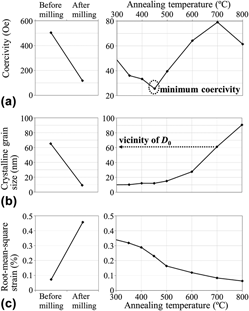Article contents
Fabrication of nanogranular flakes of magnetic metallic nanoparticles in an oxide matrix
Published online by Cambridge University Press: 10 November 2016
Abstract

Novel nanogranular flakes in which magnetic metallic nanoparticles are highly dispersed in an oxide matrix were fabricated for use as a constituent material in bulk nanogranular composites. A simple milling process using core/shell nanoparticles of magnetic metal/oxide was used to produce nanogranular flakes composed of magnetic metallic nanoparticles in an oxide matrix. The high dispersion of the metallic nanoparticles in the oxide matrix increased the electrical resistivity of the flakes. In addition, neighboring nanoparticles in the flakes interacted with each other via magnetic exchange coupling, and the flakes exhibited good soft magnetism with low coercivity when they contained a high concentration of highly dispersed magnetic metallic nanoparticles. The coercivity of the flakes could be decreased significantly by annealing and by modifying the surface of the flakes. A minimum coercivity of 8.7 Oe was obtained using flakes with a composition of Fe0.5Ni0.5–4 wt% Si.
- Type
- Articles
- Information
- Copyright
- Copyright © Materials Research Society 2016
References
REFERENCES
- 3
- Cited by



